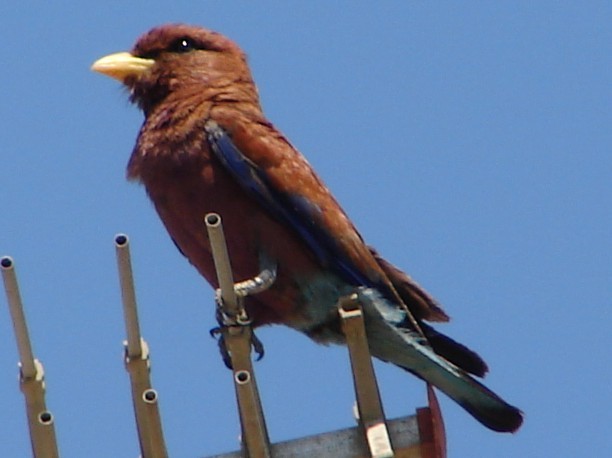Broad-billed Roller
A species of Broad-billed Rollers and Dollarbirds Scientific name : Eurystomus glaucurus Genus : Broad-billed Rollers and Dollarbirds
Broad-billed Roller, A species of Broad-billed Rollers and Dollarbirds
Botanical name: Eurystomus glaucurus
Genus: Broad-billed Rollers and Dollarbirds
Content
Description General Info
 Photo By Margaux1900 , used under CC-BY-SA-3.0 /Cropped and compressed from original
Photo By Margaux1900 , used under CC-BY-SA-3.0 /Cropped and compressed from original Description
The broad-billed roller is 29–30 cm in length. It has a warm back and head, lilac foreneck and breast, with the rest of the plumage mainly brown. The broad bill is bright yellow. Sexes are similar, but the juvenile is a drabber version of the adult, with a pale breast. The broad-billed roller is striking in its strong direct flight, with the brilliant blues of the wings and tail contrasting with the brown back. The call of the broad-billed roller is a snarling k-k-k-k-k-r-r-r-r-r sound. 
Size
29 cm
Nest Placement
Cavity
Feeding Habits
Broad-billed Roller primarily feeds on large insects, including ants, termites, beetles, and grasshoppers, occasionally lizards, fruits, and seeds. It hunts by perching and catching prey mid-flight, mostly around dusk, consuming up to 10 insects per minute.
Habitat
Broad-billed Roller thrives in diverse open woodlands with ample tall trees, often adjacent to water bodies. The species is commonly found in ecosystems such as woodland-grassland mosaics, cultivated landscapes with high trees, and expansive clearings near human settlements. Habitats range from riverine forests, floodplains, various types of woodland, as well as suburban regions with suitable vegetation. It can be observed in both highland and coastal areas, including mangroves, adapting to altitudes up to 2200 meters in Eastern Africa and 1600 meters in Madagascar, though prevalently in drier regions.
Dite type
Frugivorous
General Info
Feeding Habits
Bird food type

Fruit
Behavior
They are inactive for most of the day, apart from chasing intruders, but in late afternoon they hunt for the swarming ants and termites on which they feed, sometimes in groups of 100 or more rollers. They drink like swallows, dipping their bills into water in flight. This bird nests in an unlined hole in a tree cavity, laying 2-3 eggs. 
Distribution Area
This is a species of open woodland with some tall trees, preferably near water. These rollers often perch prominently on trees, posts or overhead wires, like giant shrikes. 
Species Status
Not globally threatened.